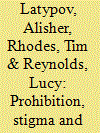|
|
|
Sort Order |
|
|
|
Items / Page
|
|
|
|
|
|
|
| Srl | Item |
| 1 |
ID:
119506


|
|
|
|
|
| Publication |
2013.
|
| Summary/Abstract |
This article provides an overview of drug consumption in the Pamirs in the late nineteenth and early twentieth centuries and examines the evolution of the early Soviet responses to opium smoking in Soviet Badakhshan on the basis of published literature, archival materials, oral histories and medical records. The author demonstrates that biomedicine remained significantly underdeveloped in that region during the first decades of Soviet rule, with central and local authorities relying on punitive and restrictive administrative measures in their fight against drug addiction. As these measures failed to wipe out opiate addiction in Gorno-Badakhshan, the opium war at the 'roof of the world' culminated in the Great Terror, providing the Stalinist regime with the 'radical' solution by liquidating drug dealers without any 'show trials' and incarcerating opiate consumers. The consequences of such administrative regulation of addiction in Soviet Badakhshan were dire: in the years between 1941 and 1968, only few patients with the diagnosis of narkomania were hospitalized in the Tajik Republican Psychiatric Hospital, while the exact numbers of repressed drug users who perished in prisons and Gulag camps are destined to remain unknown.
|
|
|
|
|
|
|
|
|
|
|
|
|
|
|
|
| 2 |
ID:
119508


|
|
|
|
|
| Publication |
2013.
|
| Summary/Abstract |
Conscious of a paucity of evidence, and drawing upon a combination of historical documentary material, research literature and surveillance data, this paper offers a commentary on the social, historical and HIV contexts affecting men who have sex with men in Central Asia. The authors describe the history of men who have sex with men in the five Central Asian republics, before, during and after the Soviet-imposed legal prohibition, which continues in Turkmenistan and Uzbekistan, the only nations in the World Health Organization Europe region where sex between men remains illegal. This historical context frames contemporary responses to men who have sex with men. Despite long-established homoerotic traditions, modern attitudes to men who have sex with men are marked by great hostility, generating stigmatization of sex between men and discrimination against men suspected of it. The losses following public exposure can be severe: loss of employment; limited/lack of health-care access; and safety from physical and sexual assault. Such hostility creates an environment of increased HIV risk, and constrains the production of reliable HIV evidence. The authors argue that the generation of HIV risk, HIV-prevention responses and HIV evidence are products of their historical and social contexts, and call attention to the urgent need for HIV prevention and structural reforms to protect the health of men who have sex with men in Central Asia.
|
|
|
|
|
|
|
|
|
|
|
|
|
|
|
|
|
|
|
|
|